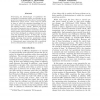Free Online Productivity Tools
i2Speak
i2Symbol
i2OCR
iTex2Img
iWeb2Print
iWeb2Shot
i2Type
iPdf2Split
iPdf2Merge
i2Bopomofo
i2Arabic
i2Style
i2Image
i2PDF
iLatex2Rtf
Sci2ools
AAAI
1996
1996
Reasoning about Continuous Processes
Overcoming the disadvantages of equidistant discretization of continuous actions, we introduce an approach that separates time into slices of varying length bordered by certain events. Such events are points in time at which the equations describing the system's behavior--that is, the equations which specify the ongoing processes--change. Between two events the system's parameters stay continuous. A high-level semantics for drawing logical conclusions about dynamic systems with continuous processes is presented, and we have developed an adequate calculus to automate this reasoning process. In doing this, we have combined deduction and numerical calculus, offering logical reasoning about precise, quantitative system information. The scenario of multiple balls moving in 1-dimensional space interacting with a pendulum serves as demonstration example of our method.
AAAI 1996 | Continuous Actions | Continuous Processes | Equidistant Discretization | Intelligent Agents |
| Added | 02 Nov 2010 |
| Updated | 02 Nov 2010 |
| Type | Conference |
| Year | 1996 |
| Where | AAAI |
| Authors | Christoph S. Herrmann, Michael Thielscher |
Comments (0)

